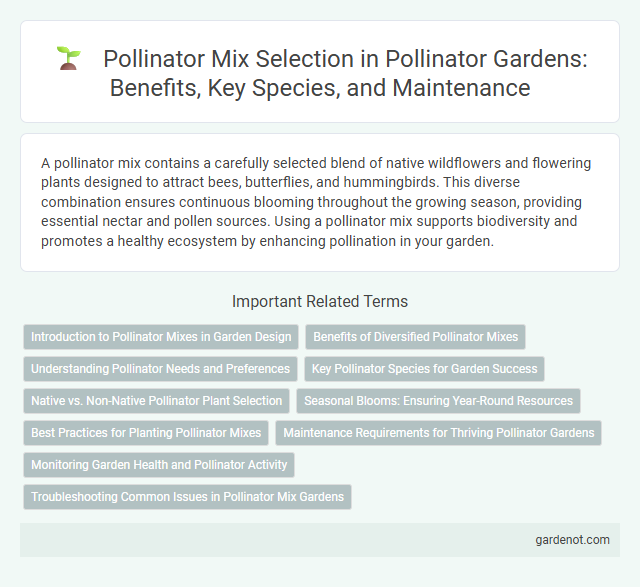A pollinator mix contains a carefully selected blend of native wildflowers and flowering plants designed to attract bees, butterflies, and hummingbirds. This diverse combination ensures continuous blooming throughout the growing season, providing essential nectar and pollen sources. Using a pollinator mix supports biodiversity and promotes a healthy ecosystem by enhancing pollination in your garden.
Introduction to Pollinator Mixes in Garden Design
Pollinator mixes combine a diverse selection of native wildflowers and grasses tailored to attract bees, butterflies, and other beneficial insects essential for garden health. These carefully curated seed blends promote biodiversity by providing continuous nectar and pollen sources throughout the growing season. Incorporating pollinator mixes into garden design enhances ecosystem resilience and supports sustainable landscaping practices.
Benefits of Diversified Pollinator Mixes
Diversified pollinator mixes enhance ecosystem resilience by supporting a wide range of pollinator species, including bees, butterflies, and hummingbirds. These mixes increase floral resources throughout different seasons, ensuring continuous nectar and pollen availability that boosts pollination efficiency and crop yields. Planting diverse native wildflowers and herbs in pollinator gardens promotes biodiversity, strengthens local ecosystems, and improves overall habitat health.
Understanding Pollinator Needs and Preferences
Pollinator mixes are specifically designed seed blends that cater to the diverse nutritional and habitat requirements of key pollinator species such as honeybees, bumblebees, butterflies, and hummingbirds. Selecting native flowering plants with staggered bloom times ensures continuous nectar and pollen availability, addressing the foraging patterns and seasonal needs of pollinators. Incorporating a variety of flower shapes and colors supports different pollinator preferences, enhancing overall ecosystem health and promoting pollinator biodiversity.
Key Pollinator Species for Garden Success
A pollinator mix designed for garden success includes native bee species such as bumblebees (Bombus spp.), solitary bees like mason bees (Osmia lignaria), and butterfly species including monarchs (Danaus plexippus). Selecting plants rich in nectar and pollen supports these key pollinators, promoting biodiversity and enhancing fruit and seed production. Incorporating diverse flowering periods ensures continuous forage availability crucial for sustaining robust pollinator populations throughout the growing season.
Native vs. Non-Native Pollinator Plant Selection
Selecting native pollinator plants supports local ecosystems by providing essential nectar and pollen resources tailored to native pollinators' needs, enhancing biodiversity and plant-pollinator interactions. Non-native pollinator plants may offer extended blooming periods but risk disrupting local habitats and can sometimes outcompete indigenous species. Prioritizing native species in pollinator mixes ensures better adaptation to local climate and soil conditions, promoting sustainable pollinator conservation efforts.
Seasonal Blooms: Ensuring Year-Round Resources
A pollinator mix designed for seasonal blooms provides continuous nectar and pollen sources from early spring through late fall, supporting diverse pollinator species year-round. Incorporating native wildflowers, annuals, and perennials with staggered bloom times maximizes habitat availability and sustains pollinator health. This strategy enhances ecosystem resilience and promotes biodiversity in managed landscapes.
Best Practices for Planting Pollinator Mixes
Planting pollinator mixes requires selecting native, nectar-rich flowers to support diverse pollinator species such as bees, butterflies, and hummingbirds. Optimal soil preparation includes ensuring well-drained, nutrient-balanced conditions and avoiding pesticide use to create a safe habitat. Regular monitoring and seasonal maintenance, like deadheading and controlled weeding, help sustain plant health and continuous bloom cycles.
Maintenance Requirements for Thriving Pollinator Gardens
Pollinator mixes require well-drained soil and regular watering during establishment to support healthy growth and flowering. Periodic pruning and removal of spent blooms enhance plant vitality and attract a continuous variety of pollinators. Minimizing pesticide use and maintaining diverse native plant species optimize habitat quality and promote sustainable pollinator populations.
Monitoring Garden Health and Pollinator Activity
Regular monitoring of pollinator gardens using a diverse pollinator mix helps assess plant health and pollinator visitation rates, which are critical for ecosystem balance. Tracking species diversity and bloom timing provides essential data for optimizing nectar and pollen availability throughout the seasons. Effective monitoring tools include visual surveys and automated sensors that quantify pollinator activity and garden vitality.
Troubleshooting Common Issues in Pollinator Mix Gardens
Pollinator mix gardens often face challenges such as poor seed germination, weed invasion, and lack of floral diversity. Ensuring proper soil preparation, using high-quality seed blends tailored to local pollinators, and implementing regular maintenance can improve plant establishment and support a thriving pollinator habitat. Monitoring moisture levels and adjusting watering schedules helps prevent plant stress and enhances pollinator attraction.
Pollinator mix Infographic

 gardenot.com
gardenot.com